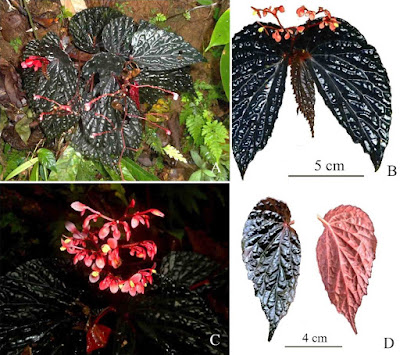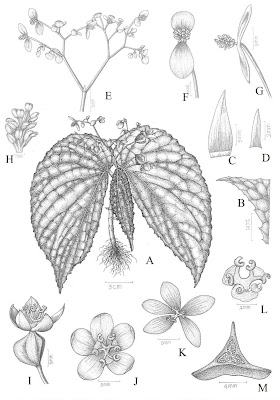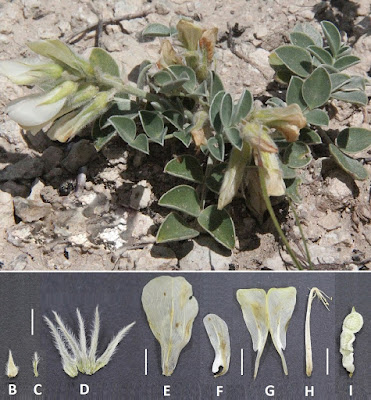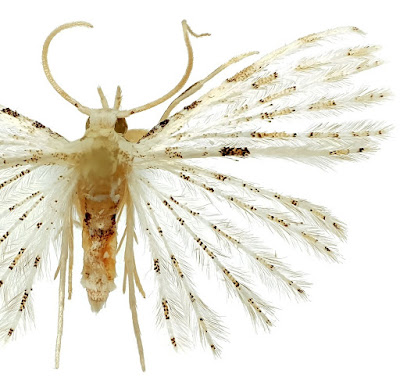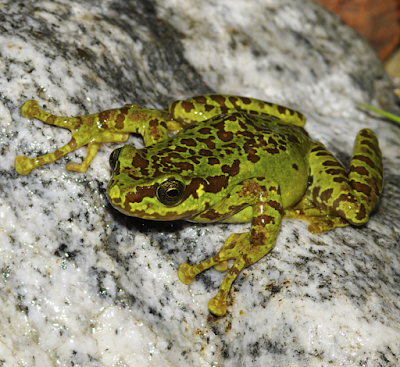[Most Recent Entries] [Calendar View]
Monday, January 6th, 2020
| Time | Event | ||||||||||
| 3:20a | [Botany • 2020] Begonia daunhitam (Begoniaceae) • A New Species of Begonia from West Kalimantan, Indonesia
ABSTRACT Begonia daunhitam, a new species from West Kalimantan, Indonesia with strongly bullate black leaves is described and illustrated here, and details of the distribution, ecology and conservation status are provided. KEY WORDS: Begonia darthvaderiana, Begonia daunhitam, Begoniaceae, Borneo, Indonesia, new taxa, taxonomy. Begonia daunhitam W.G. Wang, C.X.L. Wang, S.Z. Zhang & A. Randi, sp. nov. 黑森林秋海棠 Sect. Petermannia Type: INDONESIA. Borneo. West Kalimantan Province. Kapuas Hulu Regency, Boyan Tanjung District, ..., (..., 260 m alt.), 23 September 2016, A. Randi AR-855-KB (holotype BO!, isotype BO!). Diagnosis: This new species is similar to B. darthvaderiana in having dark olive nearly black leaves and pink flowers, but differing in having a dichasial cyme inflorescence, adaxial surface of leaves being strongly bullate, denticulate at the margin and without a narrow silvery band along the leaves margin and many more stamens (fig. 3). Distribution: Endemic to Borneo, so far only recorded from ..., Boyan Tanjung district, Kapuas Hulu regency, West Kalimantan province, Indonesia (Fig. 4). Habitat: Grows in wet areas on slopes near the river under dense canopies of dipterocarp forest at elevation 200–300 m asl. Etymology: The specific epithet refers to the color of the leaves in Bahasa Indonesia, daun hitam = black leaves (daun = leaves, hitam = black). Wen-Guang Wang, Agusti Randi, Cheng-Xin-Luo Wang, Jian-Yong Shen, Xing-Da Ma, Ji-Pu Shi, Ting Xu and Shou-Zhou Zhang. 2020. Begonia daunhitam, A New Species of Begonia (Begoniaceae) from West Kalimantan, Indonesia. Taiwania. 65(1); 27-32. DOI: 10.6165/tai.2020.65.27 | ||||||||||
| 7:46a | [Botany • 2020] Hedysarum turcicum (Fabaceae: Hedysareae) • A New Species from Inner Anatolia, Turkey
Abstract Hedysarum turcicum, a new species endemic to Inner Anatolia, Turkey, is described and illustrated. The new species belongs to sect. Multicaulia in Hedysarum (Fabaceae) and it is related to H. elegans, H. cappadocicum, and H. persicum. Its description, images, chorology, and ecology, are provided. The diagnostic morphological characteristics, as well as a full description, ecological characteristics, and distribution data are given. Keywords: Hedysarum, new species, Yozgat, Inner Anatolia, Turkey, Eudicots
Hedysarum turcicum Hamzaoğlu & Koç, sp. nov. Diagnosis:— Hedysarum turcicum is related to H. elegans in inflorescence, calyx and corolla dimensions, and pod number of segments, but can be distinguished by bracts (5–6 mm long and ovate-lanceolate versus 8–15 mm long and linear-lanceolate), bracteoles (3.5–4.5 mm long versus (7–)8–11 mm long), corolla colour (white or sometimes very pale pinkish versus purplish), and width of keels (6–8 mm versus 4–5 mm) in H. elegans (Table 1). Habitat and Ecology:— Hedysarum turcicum belongs to Irano-Turanian phytogeographic region and is an endemic species for Inner Anatolia according to the current distribution information (Fig. 2). The species prefers marly steppes from around 1200–1400 meters. In general, these areas are under the influence of arid summers and a cold climate in winter. For now, it is estimated that it has grown in approximately 4 sq.km. only at the type locality. On the other hand; Boğazlıyan, Yenifakılı, Çayıralan districts in Yozgat province, and Felahiye, Özvatan, Sarıoğlan districts in Kayseri province have similar climate and soil areas are common. The species is very likely to grow in these areas. Therefore, it was decided that it would be appropriate to collect more data to determine the threat category of the new species. Proposed Turkish name for the new species:—Türk batalağı. Ergin Hamzaoğlu and Murat Koç. 2020. Hedysarum turcicum (Hedysareae, Fabaceae), A New Species from Turkey. Phytotaxa. 428(1); 1–6. DOI: 10.11646/phytotaxa.428.1.1 | ||||||||||
| 8:50a | [Entomology • 2019] Alucita udovichenkoi • A New Species of Many-plumed Moths (Lepidoptera: Alucitidae) from the Republic of South Africa
The article describes a new species of many-plumed moth, Alucita udovichenkoi Kovtunovich & Ustjuzhanin sp. nov., from the province Mpumalanga, the Republic of South Africa.
Alucita udovichenkoi Kovtunovich & Ustjuzhanin sp. nov. Etymology. The species is named after the Russian entomologist Pavel Udovichenko (Moscow), participant of numerous expeditions in South Africa. Vasiliy Kovtunovich, Petr Ustjuzhanin and Alexander Streltzov. 2019. New Species of Many-plumed Moths (Lepidoptera: Alucitidae) from the Republic of South Africa. Ecologica Montenegrina. 26; 1-3. biotaxa.org/em/article/view/58448/58753 | ||||||||||
| 10:26a | [Herpetology • 2019] Amolops pallasitatus • A New Species of Amolops (Anura: Ranidae) from Tibet, China
Abstract A new species, Amolops pallasitatus sp. nov. is described based on specimens collected from Chentang Town, Dinggyê County, southern Tibet, China. The new species can be distinguished from other known congeners by mitochondrial divergence and morphological characteristics including: (1) medium body size, SVL 70.6–72.3 mm in adult females; (2) skin smooth over the entire body; (3) absence of dorsolateral fold; (4) tympanum small, edge indistinct, less than half of eye diameter; (5) vomerine teeth in two short oblique; (6) circummarginal and transverse grooves absent on disk of the first finger; (7) presence of inner metacarpal tubercle; (8) toes fully webbed, webbing formula I 0 - 0- II 0 - ? III0 - 1+ IV 1+ - 0 V; (9) absence of outer metatarsal tubercle and tarsal glands; (10) tibio-tarsal articulation of the hind limb reaches posterior corners of the eye; (11) dorsum yellow-green, with irregular dark brown blotches without margins; (12) blotches concentrated on the dorsum, less on the flanks. In morphology, Amolops pallasitatus sp. nov. is similar to A. himalayanus and A. formosus, the difference between them is length of hind limbs, web of toe and dorsal colour pattern. The systematic placement of the new species within the genus is unresolved and it is not assigned to any recognized species group, for the lack of convictive evidences. Keywords: Amolops pallasitatus sp. nov.; mitochondrial; morphology; unknown species group; torrent frog
Amolops pallasitatus Qi, Zhou, Lyu, Lu & Li, sp. nov. Diagnosis. Amolops pallasitatus sp. nov. is distinguished from its congeners by a combination of the following morphological characteristic: (1) medium body size, SVL 70.6–72.3 mm in adult females; (2) skin smooth over the entire body; (3) absence of dorsolateral fold; (4) tympanum small, edge indistinct, less than half of eye diameter; (5) vomerine teeth in two short oblique; (6) circummarginal and transverse grooves absent on disk of the first finger; (7) presence of inner metacarpal tubercle; (8) toes fully webbed, webbing formula I 0 - 0- II 0 - ½ III0 - 1+ IV 1+ - 0 V; (9) absence of outer metatarsal tubercle and tarsal glands; (10) tibio-tarsal articulation of the hind limb reaches posterior corners of the eye; (11) dorsum yellow-green, with irregular dark brown blotches without margins; (12) blotches concentrated on the dorsum, less on the flanks.
Etymology: The specific name pallasitatus means “pallasite like”, which derived from meteoritics term pallasite (a class of stony–iron meteorite). The name refers to the numerous irregular dark brown blotches on the dorsal background resembling olivine crystals in an iron-nickel matrix. According to the type locality, we suggest the English common name as “Chentang cascade frog”, and the Chinese common name as “chén táng tuān wā” ( 陈塘湍蛙). Distribution: Currently, this species is only known from Chentang Town, Dinggyê County, Tibet, China, presumably also distributed in Nepal. Ecology and habitat: All the specimens were caught at night, living in high-altitude (3270 m a.s.l.) streams within moist forest and grassland habitats (Figure 7). The frog is hidden underwater during the day. When disturbed, it jumped into the water immediately. Shuo Qi, Zhengyan Zhou, Zhitong Lyu, Yuyan Lu, Han Wan, Mian Hou, Keji Guo and Pipeng Li. 2019. Description of A New Species of Amolops (Anura: Ranidae) from Tibet, China. Asian Herpetological Research. 10(4); 219-229. DOI: 10.16373/j.cnki.ahr.190016 |
| << Previous Day |
2020/01/06 [Calendar] |
Next Day >> |
